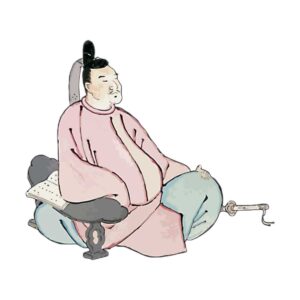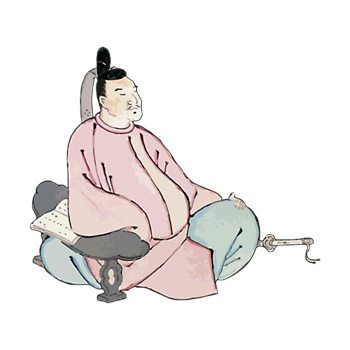
Tea master, Kobori Enshu, Kobori Masakazu
Lord of Omi Komuro domain (12,000 koku) and a feudal tea master in the early Edo period. Born in the country of Omi. He received gifted education from his father Shinsuke Masatsugu from his childhood, and inherited the main line of tea ceremony from Sen no Rikyu and Furuta Oribe, and became an instructor of the tea ceremony for the Tokugawa shoguns. In 1608, he served as a magistrate of Sunpu Castle, and for his services, he was appointed to the rank of “Morotayu” (a lord of the fifth rank) and “Enshu,” from which he received the name “Enshu.
During his lifetime, he held more than 400 tea ceremonies and invited over 2,000 guests from all walks of life, including feudal lords, court nobles, Hatamoto, and merchants. He excelled in calligraphy, painting, and waka poetry, and combined the tea ceremony with the philosophy of the imperial culture to create the elegant and elegant tea ceremony called kireisabi (beauty and simplicity).
Enshu was a central figure in the Kan’ei cultural salons, including those of Emperor Gosui, and as a magistrate, he also demonstrated his talents in the construction and landscaping of the Katsura Imperial Villa, Sento Palace, Nijo Castle, and Nagoya Castle.
Daitokuji Temple’s Kogo-an Garden and Nanzenji Temple’s Kinji-in Garden are representative examples of his work.
In the field of arts and crafts, he left a great mark in the selection of “Chuko Meimono” and in the teaching of tea ceremony utensils of national pottery such as Takatori, Tanba, Shigaraki, Iga, and Shidoro. He also devoted himself to ordering tea ceramics from China, Korea, Holland, and other foreign countries.
Enshu lived through the turbulent period from Toyotomi to Tokugawa, reconstructed the lineage of Japanese beauty, and gave birth to a new sense of beauty and elegance in the early modern age, laying the foundation for a more peaceful era.
Tea master. Born in 1579 (Tensho 7), Enshu was the founder of the Enshu school of tea ceremony.
Born in 1579, his first name was Masakazu, and his last name was Sakusuke. He was a great admirer of both Haruya and Egetsu, and was called Sobo Taiyu and Korogo-an. He was appointed as a fifth-grade samurai in charge of Enshu, so he was called Enshu or Lord Enshu in honor of Enshu. He was born in Kobori, Sakata-gun, Omi Province (Kobori-machi, Nagahama City, Shiga Prefecture) as the eldest son of Kobori Masatsugu, a vassal of Toyotomi Hidenaga, lord of Yamatokoriyama Castle. 1604 (Keicho 9), at the age of 26, he inherited Matsuyama Castle in Bitchu (Okayama Prefecture), his father’s estate, of 12,000 koku, and was appointed as the governor of En-o in 1619 (Genna 5), when his domain in Bitchu was transferred to Omuro (Asai-cho At the age of 20, he was ordered to be in charge of the construction of Fushimi Castle, Goyozeiin Temple, and Sunpu Castle, and at the age of 20, he was in charge of the construction of the inner palace, the garden of Sento Palace, Nijo Castle, Mizuguchi Tea House in Osaka Castle, Nishinomaru in Edo Castle, Shinagawa Palace, Tokaiji Temple, Nanzenji Temple, and other buildings. He was in charge of the construction of Nijo Castle, the Mizuguchi teahouse at Osaka Castle, Nishinomaru at Edo Castle, the Shinagawa Palace, Tokaiji Temple, Nanzenji Temple, and other temples. In addition, while serving as a magistrate in Fushimi, he was appointed as a political advisor to Yorinobu, Marquis of Kishu, and as an inspector of the Five Kinai Provinces on more than a dozen occasions. In 1645, at the age of 67, he was granted a leave of absence and returned to his Fushimi residence to spend some time with his family. He enjoyed tea ceremonies at Seishu-in, Tengo-an, Shosui-tei, and other places he liked. Enshu learned the tea ceremony from Furuta Oribe, with whom he had a close friendship for 20 years since he was about 18 years old. Enshu’s tea ceremonies were so-called “kirei- sabi,” a combination of the samurai and court noble dynasties’ styles, and he preferred to use not only Waicha, a small tatami room, but also the bright atmosphere of Shoin and Chain Room as a place for socializing and culture of the feudal lords, and many of the utensils were of neat and elegant style. Enshu studied waka poetry from early on under the tutelage of Kinoshita Nagayoko and Reizei Tamemitsu, and his travel writings, such as “Muneho-no-Ko’s Travel Diary,” are still extant. In Zen, Enshu studied under Zen master Haruya Soen and received the title of “Tairu,” or the way of the great master. In calligraphy, Enshu respected the style of Teika, and he is considered one of the three most famous calligraphers of the Kan’ei period, along with Konoe Ozan and Shokado Shoujyo. Regarding Enshu and ceramics, his numerous collections and findings were later called “chukko meimono” in contrast to the great meimono of the Higashiyama period, and he chose elegant poem inscriptions from the Kokinshu and other imperial waka anthologies for his tea containers and other inscriptions. He also added new antique value to tea utensils, for example, by using lacquered boxes with decorative gold-powder inscriptions; he had various domestic kilns produce his favorites, as in the so-called “Enshu seven kilns”; he sent Gohon to the Busan kiln in Korea to have new tea utensils made; and it is estimated that he ordered new works in kirigata from China, including some in blue and some in red, and favored new works in shozui. He died on February 6, 1647, at the age of 69. He wrote in his resignation, “Kinofu to hifu to shitsureru no mimo no yumenosamu akebono. Enshu was the second great master of the tea ceremony after Murata Shuko, Takeno Shaogu, Sen no Rikyu, and Furuta Oribe, especially because of the authority of the shogunate, and the tradition eventually remained as the Enshu style for a long time. His disciples included Shokado Shoujyo, Kuroda Shogen, Yamada Taiyu, Sakuma Naokatsu, and Omori Murata Issai, and his sons were Ozen Masayuki (Sokei) and Gonjuro Masayun (Hozetsu).



